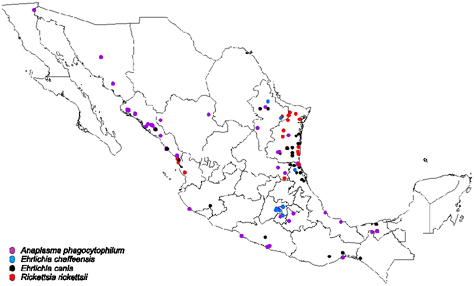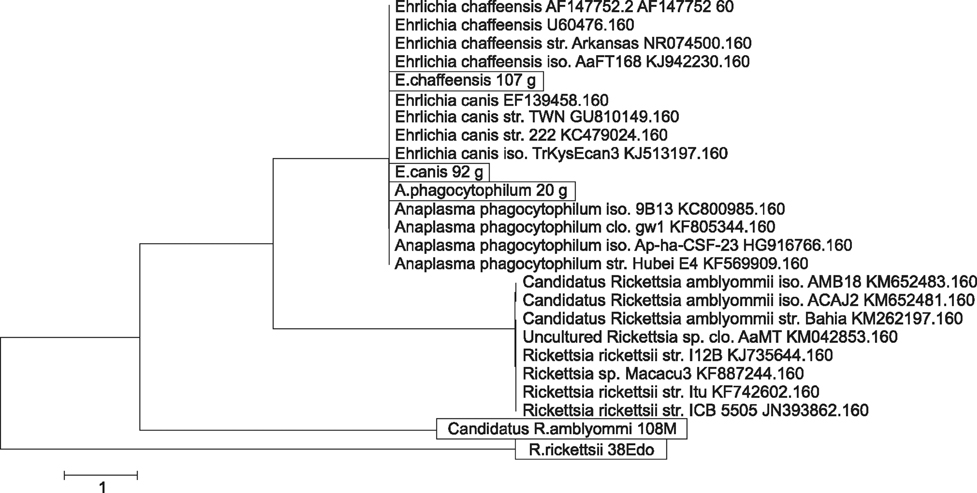J Vet Sci.
2016 Sep;17(3):353-360. 10.4142/jvs.2016.17.3.353.
Tick-borne rickettsial pathogens in questing ticks, removed from humans and animals in Mexico
- Affiliations
-
- 1Unit of Research in Infectious Diseases, Children Hospital, National Medical Center, Institute of Mexico Social Security, Mexico City 06720, Mexico. csosa.lanagesa@gmail.com
- 2Department of Entomology, Faculty of Agrobiology, Universidad Michoacana de San Nicolás de Hidalgo, Uruapan 60150, Mexico.
- KMID: 2413135
- DOI: http://doi.org/10.4142/jvs.2016.17.3.353
Abstract
- Tick-borne rickettsial diseases (TBRD) are commonly encountered in medical and veterinary clinical settings. The control of these diseases is difficult, requiring disruption of a complex transmission chain involving a vertebrate host and ticks. The geographical distribution of the diseases is related to distribution of the vector, which is an indicator of risk for the population. A total of 1,107 ticks were collected by tick dragging from forests, ecotourism parks and hosts at 101 sites in 22 of the 32 states of Mexico. Collected ticks were placed in 1.5 mL cryovials containing 70% ethanol and were identified to species. Ticks were pooled according to location/host of collection, date of collection, sex, and stage of development. A total of 51 ticks were assayed by polymerase chain reaction (PCR) to confirm species identification using morphological methods. A total of 477 pools of ticks were assayed using PCR techniques for selected tick-borne pathogens. Anaplasma phagocytophilum was the most commonly detected pathogen (45 pools), followed by, Ehrlichia (E.) canis (42), Rickettsia (R.) rickettsii (11), E. chaffeensis (8), and R. amblyommii (1). Rhipicephalus sanguineus was the tick most frequently positive for selected pathogens. Overall, our results indicate that potential tick vectors positive for rickettsial pathogens are distributed throughout the area surveyed in Mexico.
Keyword
MeSH Terms
-
Anaplasma/classification/genetics/*physiology
Anaplasmosis/epidemiology/microbiology
Animals
Arachnid Vectors/*microbiology
DNA, Bacterial/genetics
Ehrlichia/classification/genetics/*physiology
Ehrlichiosis/epidemiology/microbiology/veterinary
Female
Humans
Ixodidae/*microbiology
Male
Mexico/epidemiology
Phylogeny
Polymerase Chain Reaction/veterinary
RNA, Ribosomal, 16S/genetics
Rickettsia/classification/genetics/*physiology
Rickettsia Infections/epidemiology/microbiology/veterinary
Sequence Analysis, DNA/veterinary
Tick-Borne Diseases/*epidemiology/microbiology/veterinary
DNA, Bacterial
RNA, Ribosomal, 16S
Figure
Reference
-
1. Apperson CS, Engber B, Nicholson WL, Mead DG, Engel J, Yabsley MJ, Dail K, Johnson J, Watson DW. Tick-borne disease in North Carolina: is "Rickettsia amblyommii" a possible cause of rickettsiosis reported as Rocky Mountain spotted fever? Vector Borne Zoonotic Dis. 2008; 8:597–606.
Article2. Burlini L, Texeira KRS, Szabó MPJ, Famadas KM. Molecular dissimilarities of Rhipicephalus sanguineus (Acari: Ixodidae) in Brazil and its relation with samples throughout the world: is there a geographical pattern? Exp Appl Acarol. 2010; 50:361–374.
Article3. Bustamante-Calvillo ME, Varela G, Mariotte CO. Studies of spotted fever in Mexico: spotted fever in the Laguna. Rev Inst Salubr Enferm Trop. 1946; 7:39–49.4. Bustamante ME, Varela G. Studies of spotted fever in Mexico: the role of Rhipicephalus sanguineus in the transmission of spotted fever in Mexico. Rev Inst Salubr Enferm Trop. 1947; 8:139–141.5. Brouqui P. Ehrlichiosis in Europe. In : Raoult D, Brouqui P, editors. Rickettsiae and Rickettsial Diseases at the Turn of the Third Millennium. Paris: Elsevier;2002. p. 220–232.6. Bröker M. Following a tick bite: double infections by tick-borne encephalitis virus and the spirochete Borrelia and other potential multiple infections. Zoonoses Public Health. 2012; 59:176–180.
Article7. Chmielewska-Badora J, Moniuszko A, Żuliewicz-Sobczak W, Zwoliński J, Piatek J, Pancewicz S. Serological survey in persons occupationally exposed to tick-borne pathogens in cases of co-infections with Borrelia burgdorferi, Anaplasma phagocytophilum, Bartonella spp. and Babesia microti. Ann Agric Environ Med. 2012; 19:271–274.8. Dantas-Torres F, Chomel BB, Otranto D. Ticks and tick-borne diseases: a One Health perspective. Trends Parasitol. 2012; 28:437–446.
Article9. Dantas-Torres F, Giannelli A, Otranto D. Starvation and overwinter do not affect the reproductive fitness of Rhipicephalus sanguineus. Vet Parasitol. 2012; 185:260–264.
Article10. Demma LJ, Traeger MS, Nicholson WL, Paddock CD, Blau DM, Eremeeva ME, Dasch GA, Levin ML, Singleton J Jr, Zaki SR, Cheek JE, Swerdlow DL, McQuiston JH. Rocky Mountain spotted fever from an unexpected tick vector in Arizona. N Engl J Med. 2005; 353:587–594.
Article11. Dong J, Olano JP, McBride JW, Walker DH. Emerging pathogens: challenges and successes of molecular diagnostics. J Mol Diagn. 2008; 10:185–197.
Article12. Durden LA. Taxonomy, host associations, life cycles and vectorial importance of ticks parasitizing small mammals. In : Morand S, Krasnov BR, Poulin R, editors. Micromammals and Macroparasites: From Evolutionary Ecology to Management. Tokyo: Springer;2006. p. 91–102.13. Feria-Arroyo TP, Castro-Arellano I, Gordillo-Perez G, Cavazos AL, Vargas-Sandoval M, Grover A, Torres J, Medina RF, de León AAP, Esteve-Gassent MD. Implications of climate change on the distribution of the tick vector Ixodes scapularis and risk for Lyme disease in the Texas-Mexico transboundary region. Parasit Vectors. 2014; 7:199.14. Gongóra-Biachi RA, Zavala-Velázquez J, Castro-Sansores CJ, González-Martínez P. First case of human ehrlichiosis in Mexico. Emerg Infect Dis. 1999; 5:481.
Article15. Gordillo-Pérez G, Vargas M, Solórzano-Santos F, Rivera A, Polaco OJ, Alvarado L, Muñóz O, Torres J. Demonstration of Borrelia burgdorferi sensu stricto infection in ticks from the northeast of Mexico. Clin Microbiol Infect. 2009; 15:496–498.
Article16. Gubler DJ, Reiter P, Ebi KL, Yap W, Nasci R, Patz JA. Climate variability and change in the United States: potential impacts on vector- and rodent-borne diseases. Environ Health Perspect. 2001; 102:223–233.
Article17. Guzmán-Cornejo C, Robbins RG. The genus Ixodes (Acari: Ixodidae) in Mexico: adult identification keys, diagnoses, host, and distribution. Rev Mex Biodivers. 2010; 81:289–298.18. Hai VV, Almeras L, Socolovschi C, Raoult D, Parola P, Pagès F. Monitoring human tick-borne disease risk and tick bite exposure in Europe: available tools and promising future methods. Ticks Tick Borne Dis. 2014; 5:607–619.
Article19. Hamer SA, Tsao JI, Walker ED, Mansfield LS, Foster ES, Hickling GJ. Use of tick surveys and serosurveys to evaluate pet dogs as a sentinel species for emerging Lyme disease. Am J Vet Res. 2009; 70:49–56.
Article20. Hinrichsen VL, Whitworth UG, Breitschwerdt EB, Hegarty BC, Mather TN. Assessing the association between the geographic distribution of deer ticks and seropositivity rates to various tick-transmitted disease organisms in dogs. J Am Vet Med Assoc. 2001; 218:1092–1097.
Article21. Hoffman A. Monograph of Ixodoiea in Mexico. Part 1. Rev Soc Mex Hist Nat. 1962; 23:191–307.22. Illoldi-Rangel P, Rivaldi CL, Sissel B, Trout Fryxell R, Gordillo-Pérez G, Rodríguez-Moreno A, Williamson P, Montiel-Parra G, Sánchez-Cordero V, Sarkar S. Species distribution models and ecological suitability analysis for potential tick vectors of Lyme disease in Mexico. J Trop Med. 2012; 2012:959101.
Article23. Ismail N, Bloch KC, McBride JW. Human ehrlichiosis and anaplasmosis. Clin Lab Med. 2009; 30:261–292.
Article24. Jones EK, Clifford CM, Keirans JE, Kohls GM. The ticks of Venezuela (Acarina: Ixodidae), with a key to the species of Amblyomma in the western hemisphere. Brigham Young Univ Sci Bull Biol Ser. 1972; 17:1–46.25. Medina-Sanchez A, Bouyer DH, Alcantara-Rodriguez V, Mafra C, Zavala-Castro J, Whitworth T, Popov VL, Fernandez-Salas I, Walker DH. Detection of typhus group Rickettsia in Amblyomma ticks in the State of Nuevo Leon, Mexico. Ann N Y Acad Sci. 2005; 1063:327–332.
Article26. Labruna MB, Pacheco RC, Nava S, Brandão PE, Richtzenhain LJ, Guglielmone AA. Infection by Rickettsia belli and Candidatus "Rickettsia amblyommii" in Amblyomma neumanni ticks from Argentina. Microb Ecol. 2007; 54:126–133.
Article27. Labruna MB, Whitworth T, Bouyer DH, McBride J, Camargo LMA, Camargo EP, Popov V, Walker DH. Rickettsia bellii and Rickettsia amblyommii in Amblyomma ticks from the State of Rondônia, western Amazon, Brazil. J Med Entomol. 2004; 41:1073–1081.
Article28. Oliveira KA, Pinter A, Medina-Sanchez A, Boppana VD, Wikel SK, Saito TB, Shelite T, Blanton L, Popov V, Teel PD, Walker DH, Galvao MAM, Mafra C, Bouyer DH. Amblyomma imitator ticks as vectors of Rickettsia rickettsii, Mexico. Emerg Infect Dis. 2010; 16:1282–1284.29. Parola P, Raoult D. Ticks and tickborne bacterial diseases in humans: an emerging infectious threat. Clin Infect Dis. 2001; 32:897–928.
Article30. Pfäffle M, Littwin N, Muders SV, Petney TN. The ecology of tick-borne diseases. Int J Parasitol. 2013; 43:1059–1077.
Article31. Sanogo YO, Parola P, Shpynov S, Camicas JL, Brouqui P, Caruso G, Raoult D. Genetic diversity of bacterial agents detected in ticks removed from asymptomatic patients in norrtheastern Italy. Ann N Y Acad Sci. 2003; 990:182–190.
Article32. Solano-Gallego L, Rossi L, Scroccaro AN, Montarsi F, Caldin M, Furlanello T, Trotta M. Detection of Leishmania infantum DNA mainly in Rhipicephalus sanguineus male removed from dogs living in endemic areas of canine leishmaniosis. Parasit Vectors. 2012; 5:98.33. Sosa-Gutierrez CG, Quintero Martinez MT, Gaxiola Camacho SM, Cota Guajardo S, Esteve-Gassent MD, Gordillo-Pérez MG. Frequency and clinical epidemiology of canine monocytic ehrlichiosis in dogs infested with ticks from Sinaloa, Mexico. J Vet Med. 2013; 2013:797019.
Article34. Sosa-Gutiérrez CG, Vargas M, Torres J, Gordillo-Pérez MG. Tick-borne rickettsial pathogens in rodents from Mexico. J Biomed Sci Eng. 2014; 7:884–889.
Article35. Tamura K, Peterson D, Peterson N, Stecher G, Nei M, Kumar S. MEGA5: Molecular Evolutionary Genetic Analysis using maximum likelihood, evolutionary distance, and maximum parsimony methods. Mol Biol Evol. 2011; 28:2731–2739.
Article36. Tinoco-Gracia L, Quiroz-Romero H, Quintero-Martínez MT, Rentería-Evangelista TB, Barreras-Serrano A, Hori-Oshima S, Medina-Basulto G, Vinasco J, Moro MH. Prevalence and risk factors for Borrelia burgdorferi infection in Mexicali, Baja California, a Mexico-US border city. Int J Appl Res Vet Med. 2008; 6:161–165.37. Vargas-Sandoval M, Priego-Santander AG, Larrazábal A, Sosa-Gutierrez CG, Lara-Chávez MB, Ávila-Val TC. Potential species distribution and richness of Ixodidae ticks associated with wild vertebrates from Michoacán, Mexico. J Geogr Inf Syst. 2014; 6:467–477.38. Venzal JM, Estrada-Peña A, Portillo A, Mangold AJ, Castro O, De Souza CG, Félix ML, Pérez-Martínez L, Santibánez S, Oteo JA. Rickettsia parkeri: a rickettsial pathogen transmitted by ticks in endemic areas for spotted fever rickettsiosis in southern Uruguay. Rev Inst Med Trop Sao Paulo. 2012; 54:131–134.
Article39. Walker DH, Paddock CD, Dumler JS. Emerging and re-emerging tick-transmitted rickettsial and ehrlichial Infections. Med Clin North Am. 2008; 92:1345–1361.
Article40. Wikswo ME, Hu R, Metzger ME, Eremeeva ME. Detection of Rickettsia rickettsii and Bartonella henselae in Rhipicephalus sanguineus ticks from California. J Med Entomol. 2007; 44:158–162.
Article41. Williamson P, Billingsley P, Teltow GJ, Seals JP, Turnbough MA, Atkinson SE. Borrelia, Ehrlichia, and Rickettsia spp. in ticks removed from persons, Texas, USA. Emerg Infect Dis. 2010; 16:441–446.
Article
- Full Text Links
- Actions
-
Cited
- CITED
-
- Close
- Share
- Similar articles
-
- Prevalence of Tick-Borne Pathogens from Ticks Collected from Cattle and Wild Animals in Tanzania in 2012
- Present state and future of tick-borne infectious diseases in Korea
- Identification and Molecular Analysis of Ixodid Ticks (Acari: Ixodidae) Infesting Domestic Animals and Tick-Borne Pathogens at the Tarim Basin of Southern Xinjiang, China
- Review of ticks (families: Ixodidae and Argasidae) in the Republic of Korea
- Tick-Borne Pathogens in Ixodid Ticks from Poyang Lake Region, Southeastern China




